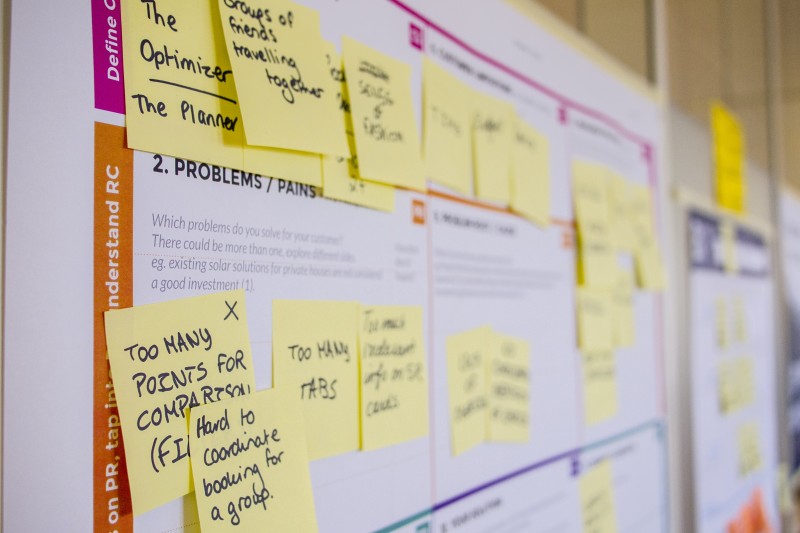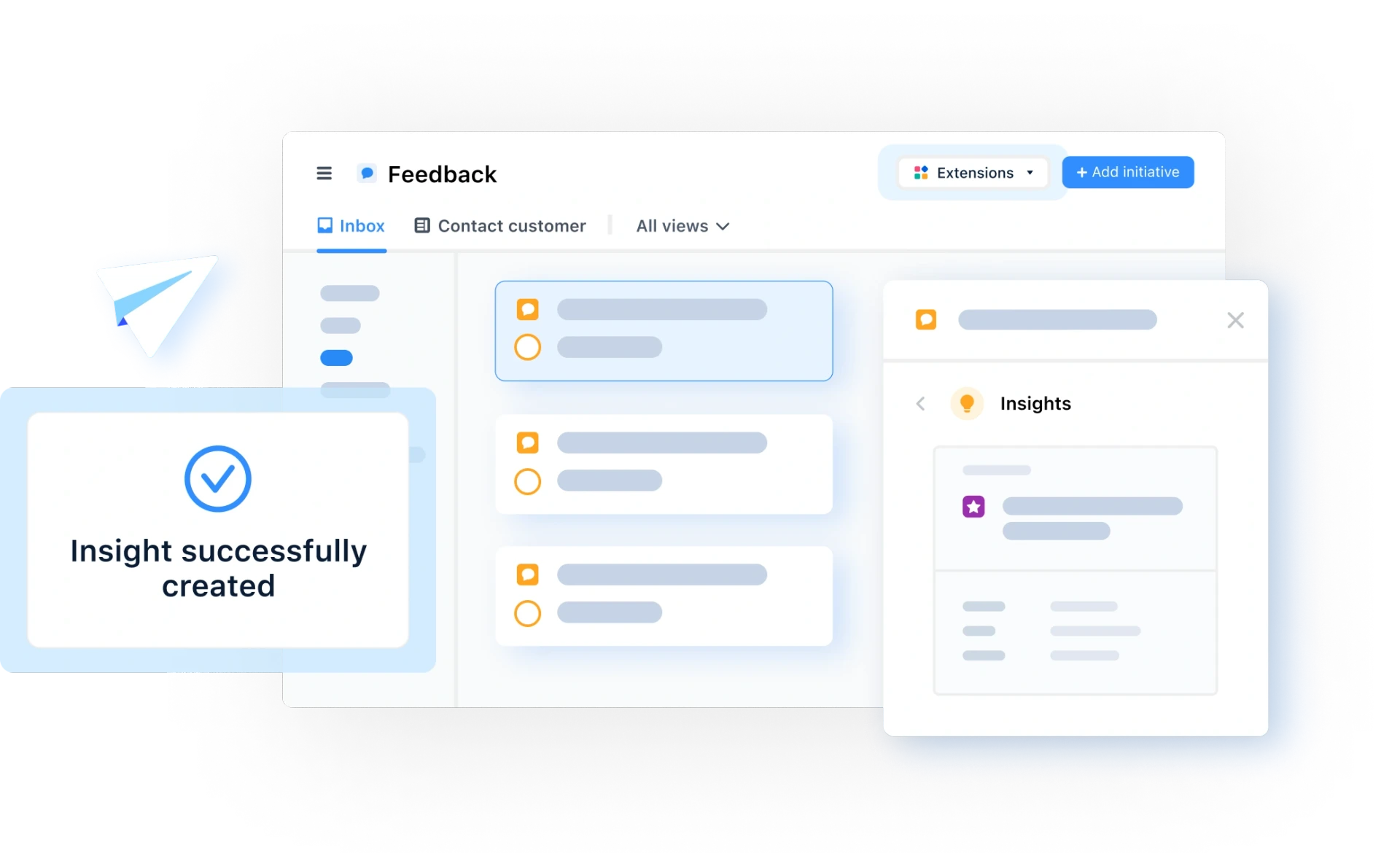31 Mar 2022
Gathering Customer Feedback - From Sourcing to Implementation and Communication
Discovery and Feedback ManagementYou’ve probably received an email asking you to rate the sender's SaaS or service from 1 to 10 with a text box to send feedback. Or maybe you’ve been asked to jump on a call to chat.
In this article, we explore ways to gather customer feedback, exploring the pros and cons of each and things you should think about before reaching out for feedback.
Why asking for customer feedback is important
Customer feedback helps improve products and services
Keeping the relevant context
How to gather and ask for customer feedback
What to do with the feedback
The process of collecting - the 5 best ways to get feedback from your customers
Why asking for customer feedback is important
We often hear phrases like “talk to your users”, “listen to your customers”, and “be the voice of the user”. These are all useful phrases to an extent, however, what does it all really mean?
To level-set expectations, I am not saying you should build everything every customer says. No, that would potentially be a misdirection of resources.
Without customers you might have a product or service, however, unfortunately, you do not have a business. The goal in my opinion is to build products (and/ or services) that customers want to use and buy.
Also please note the distinction between a customer and a consumer (user.) A customer is one who generally makes the purchase. A consumer is generally the person that uses the product or service.

Including customers in the process gives them a sense of ownership in the product and access to information that you may not be able to get access to otherwise.
Especially in the B2B market where the product manager likely isn’t the user and may have never used the product.
The insights shared can help guide the direction and growth of the product when applied objectively.
What is Customer Feedback?
Customer feedback comes in many forms. In my opinion, the bottom line is customer feedback is insights from the customer pertaining to their experience buying, using, and often cancelling the product.
Customer feedback helps improve products and services
The way in which customers buy has shifted and the number of choices customers have where to spend their money is increasing. Many markets are becoming saturated and it is becoming increasingly difficult to stand out.
Customer feedback allows the product manager to effectively prioritize what to build next and why.
Analyze feedback and tie requests to revenue impact
Understand how the product is being used and what the customer is looking to accomplish
Start conversations about product requirements
Predict and prevent churn
Lower time to value
Keeping the relevant context
Context and timely feedback is going to be key in the feedback gathered.
Asking for feedback on the buying experience just after someone has brought your product will be more valuable than asking for it three months down the line.
Feedback from a paying customer is likely more valuable than someone who hasn’t used your product and is not interested in becoming a paying customer.
Ask questions that are relevant and real. Not hypothetical, questions such as we are thinking of implementing [something] would you use it?
No, terrible question.
Instead, try asking do you have a challenge with [something] and if so what are you doing to solve it?
People buy and use products to solve a particular problem. Try to understand the jobs to be done.
How to gather and ask for customer feedback
Customer feedback can be found in a number of places. Sometimes feedback is solicited and sometimes given.
Before deciding on one method to gather customer feedback, ask yourself why do you want feedback and what you want to do with the feedback.
Asking for feedback without knowing your why is a potential waste of your customer's time as well as yours.
Below are seven ways to ask for feedback.
1. Schedule a 1-1 call for an exploratory customer interview.
I know I know, time is a premium quantity, and getting people on a phone, or zoom call is increasingly difficult. However, in my opinion, a 1-1 call yields the best results. You have the ability to drive the conversation.
When a customer loves a particular use case in the product you can dig deeper. Similar if the customer did not enjoy something you can dig deeper.
I like to ask the below follow-up questions:
Tell me more?
Can you be more specific?
How long has this been happening?
What have you tried?
Did that work?
What is this costing you?
How do you feel?
Remember in my opinion, during a 1-1 exploratory you should avoid:
Talking more than the interviewee
Prompting the interviewee into answering in a specific way
Trying to sell
Asking questions that add no value or insight into the reason for getting the feedback

2. Gathering customer feedback through email
If you are planning to send out a mass email, remember the feedback you receive could be mixed due to the potential lack of segmentation. Instead, my suggestion is to personalize the email to the customer you are looking for feedback from. Take a little time to show you care.
If they are a prospective customer address them with language that pertains to them. If they are a current customer and use some context specific to their needs or experience.
For example, I reached out to a SaaS company around April 2020. Using their website I sent a quick message that I am interested in using the software. At this time the SaaS did not have a self serve option. The SaaS company wanted prospects to talk to a person.
In March of 2022, I receive an email from their sales team. The first sentence read “It has been a while since my team last spoke with you about [Name of SaaS] and we have been making changes that might be relevant to your team and the reason we couldn't move forward”.
I ignored it since in effect I have been waiting since March 2020 for someone to reach out. A week later I received another email from the same person and the first sentence read “Any feedback on my previous message?”
I fully appreciate due to covid and potential resource issues the SaaS could have good intentions to follow up earlier and things just happen.
The point here is to remember customers are smart and they should be treated with respect.
Adding relevant context and not sending templated emails makes a big difference in how they are received. While this approach takes time, in my experience yields a much better response rate.
3. Surveys
When considering surveys, one of the main items you need to consider is what questions to ask and how many questions to ask.
Try to think like the person you are asking to complete the survey. Asking too many questions or asking questions that are not relevant will make people lose interest and less likely to complete the survey.
Also, another important consideration is how answers are structured, for example, a yes/ no response, a sliding scale response, or free-form text responses.
Finally, if you struggling with responses consider changing the format or offering incentives to complete the survey.
4. Gathering feedback via live chat
Generally speaking, I find prospective customers are more likely used to live chats. When they do again generally, prospective customers are looking for clarity around features and how they can use those features or better understand the process/ flow. Live chats can provide insights into what customers are looking for when evaluating software. Plus it's an opportunity for live interaction with a prospective customer.
5. Customer support tickets
Before reaching out to any customer, in my opinion, product managers need to review the customer support tickets. It is not a good look to be asking for a customer's time especially if they have open support tickets. First, work with the support team to bring the ticket to a close in a way that makes the customer happy.
Before reaching out try to evaluate previous support tickets with the following questions in mind:
What was the customer trying to accomplish?
What steps did they take?
Did the software behave the way in which we intended?
Did the customer’s point of view while using the software conflict with the way in which we want the software to behave?
If we take a step back customers will create a support ticket when they are unable to accomplish something they are trying to do. I am not saying that the software is at fault, the reason could be a number of reasons.
For example, as a user, the last time I created a support ticket was when I wanted to import some data into the system. The system did not behave as I thought it should. I reviewed the customer support documentation and could not figure out if I am missing a step or if the software developers have a different point of view.
I created a support ticket and the resolution was at a corp level setting that needed to be edited for the software to behave the way I intended.

Through this experience, the software company:
Updated their customer documentation to reflect the need to edit settings at a corp level.
Reached out to me to better understand my use case.
Especially in B2B enterprise the product manager generally speaking isn’t the user and may not have experience or lived in the user's shoes.
6. Sales calls and opportunities
In my opinion, sales calls are another goldmine of information. Sales usually have a front-line insight into prospective customers, what they are looking for and what products are being compared.
If you are able to listen in to calls with prospective customers and paying customers do it. However, I understand sometimes company dynamics and system issues prevent this from happening. In which case, focus on the following items:
How are they currently solving this problem?
How important is this problem to them and how fast do they need a solution?
If your company responds to RFI’s/ RFPs get access to the document and from the wording, you can generally tell if the RFx has been written with a particular vendor or product in mind. You’ll gain some insights into what requirements are in the evaluation criteria.
If the sales team is losing opportunities ask the sales team to try and get some feedback into why the prospective customer chose to go with another solution. In my experience the feedback can be around two things a) price (too expensive) or b) product (a specific functionality is missing or a competitor does it better).
7. Social Media
Warning, you could literally spend hours/ days/ months going down this rabbit hole. Websites such as LinkedIn, Twitter, Reddit, various speciality forums, and review sites contain so much data that you could lose hours. In this situation remember context matters.

What to do with the feedback
By now I hope you have realized customer feedback comes in many different forms and therefore, potentially lives in multiple different tools.
Firstly, centralize all your feedback.
Feedback in multiple locations in different tools and systems is a recipe for disaster and potentially leads to confusion.
If you have not yet checked out airfocus’s feedback functionality that allows you to centralize feedback from various channels and cross-functions teams to uncover actionable insights.
Cut down on the noise and organize inputs as they come in. Feel free to take a look here.
A few other things to remember:
Themes and buckets. Categorize feedback into themes and buckets. For example, if your product is available on desktop and mobile. Feedback can be separated between the two. Mobile can be further categorized into IOS and Android (provided your product is available on both platforms).
Summarize lengthy conversations. While reviewing feedback, learn to start summarizing. Think you want to share this with immediate team members and leadership. If anyone wants to review the entire conversation/ history they can read the entire feedback. For example, summarizing is very helpful when reviewing multiple back and forth’s in a support ticket. Or summarizing why a prospective customer decided to choose a competitor's product. Worst case scenario, summarizing helps you remember and communicate effectively.
A summary is very helpful when other team members might not have access to all the systems. For example, developers do not need access to the company CRM. The CRM usually holds information between the sales team and prospective customers. If a deal is won or lost generally speaking the CRM will have why we won or lost.
Links to original feedback. Sometimes you may want to see the source, especially when linking to social media. Therefore, add links where possible or take a screenshot of the feedback.
Remember just because someone provides feedback, does not mean you need to devote engineering hours to implement it. Review customer feedback as one data point in the bigger picture to help guide the direction and growth of the product when applied objectively.
The process of collecting - the 5 best ways to get feedback from your customers
Understand why you are looking to collect feedback (and write it down)
Understand your customer's context and choose how you want to reach out
Design a process for making it relevant and easy for your customers to provide feedback
Review, summarize and link the feedback
Use the feedback as a data point
How are you gathering customer feedback at your company?
I’d love to learn more about what’s worked, the challenges you face as you gather customer feedback.
Feel free to reach out and connect with me on Linkedin.

Pradip Khakhar

Read also
All product feedback in one place






